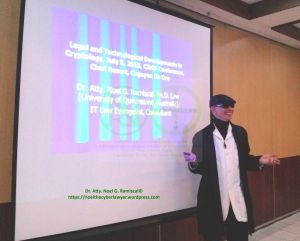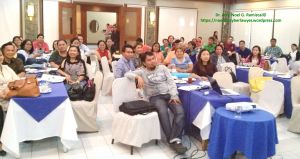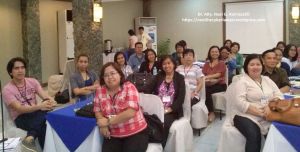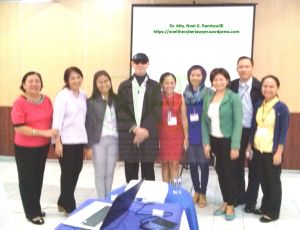In the afternoon of July 9, 2015, Dr. Atty. Noel G. Ramiscal was escorted from Xavier University to the beautiful, wonderful and classy Chali Resort and Conference Center to lecture before a group of educators and administrators comprising the Council of Deans of Arts and Sciences, Arts and Sciences Educators’ Association Region 10 (CDAS-ASEA 10).
Since this is a body of academics from mostly the sciences, physics, mathematics, engineering and economics, Dr. Ramiscal’s talk on the “Legal and Technological Developments in Cryptology” aptly fitted into their program, arranged with unerring brilliance by Ms. Nathalie Igot, the CDAS-ASEA 10 Regional Coordinator and Dr. Rolito Ebaile, the CDAS-ASEA 10 Inc. President.
Dr. Ramiscal began his lecture with an exposition of different means and modes of hiding information from prying eyes and nefarious minds, concocted by humans in ancient times. He traced the development of codes from linguistic ones to the mechanical “bombes” developed during the Second World War and how the multidisciplinary field of cryptology arose with contributions from mathematics, quantum physics, quantum mechanics, biomolecular sciences and nanotechnology. While the D-Wave system is around, he apprised the educators of the most recent advances in the building of a true quantum computer that could be the real Achilles heel for any cryptography system that relies on the problem of factoring as the kernel of the system’s security. These included the study made in Yale University of tracking in real time quantum computing errors by the use of an ancilla atom, and the development by IBM of a four superconducting quantum bit circuit device built on a chip that can be used to address quantum decoherence.
Technological advancements like these when applied to practical devices can definitely have societal and legal impact on the security and privacy of information and the lives and freedoms of people who rely on these devices. Dr. Ramiscal explained the mechanisms under the Wassenaar Arrangement that are implemented by the States parties to the Arrangement to control and regulate the dissemination of, not only the technology but the knowledge surrounding the technology, to elements and entities within and outside these States that can potentially use them for criminal purposes. These have resulted in grave clashes between the State’s interest versus the human rights and academic freedoms of educators, students and those engaged in cryptological research. In the U.S.A. the unlicensed dissemination of cryptographic materials that exceed the minimum standards under the export controls is legally prohibited. In the U.K., the teaching of Physics by a teacher without any export license to a student from a country that is identified as a hotbed of terrorism can make the teacher liable under the U.K. Terrorism Law. In Australia, anyone who disseminates cryptologic knowledge in an online environment without any export license can be construed a supplier, exporter or provider of a Weapon of Mass Destruction (WMD) if there are reasonable grounds to believe or suspect that the recipient of such knowledge will use it to build or assist in the building of a WMD.
While the Philippines is not (yet) a member of the Wassenaar Arrangement, Dr. Ramiscal delineated the relationship between this Arrangement with the Arms Trade Treaty that the Philippines signed in 2013. He discussed how cryptology is crucially connected with conventional weapons that this Treaty regulates and how that can impact the balance of power between States.
Dr. Ramiscal talked at length about the importance of source code reviews for any ICT or security products that employ cryptologic features. He elucidated on what transpired during the 2010 and 2013 automated elections and the case rulings, highlighting certain matters that should be understood by the lay public, with respect to the procurement of the machines used in these elections and the nature of source code reviews. He also brought to the attention of the attendees certain issues that need to be threshed out in the Bitcoin online exchange sites in the Philippines, and the current e-Titling system being implemented by the Land Registration Authority, which relies on cryptography for its security.
Dr. Ramiscal is most grateful to the spirited and opinionated bunch of educators who raised a lot of pertinent questions during his lecture. Thank you again to Ms. Igot and Dr. Ebaile for giving Dr. Ramiscal this wonderful opportunity to share the fruits of his research! This was memorable for Dr. Ramiscal because this was the first time that he gave this lecture to a group of educators in the sciences, and the principles and findings he discussed apparently resonated with them.




